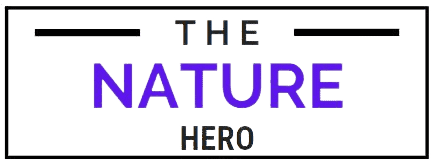I started playing Nintendo games on the compact 4:3 monitor in the 1990s, so I am more used to gaming on the classic 16:9 monitors, but pro gamers may say otherwise.
Gaming in ultra-wide curve monitors offers a more immersive gaming experience as it brings the sides of the screen within your field of view.
You might wonder if it matters. Well, it does!
Curved Monitors are suitable for gaming as they bring a sense of immersion and a wider field of vision essential for a particular gaming experience like a Flight Simulator, First-person shooting (FPS), and many other modern games.
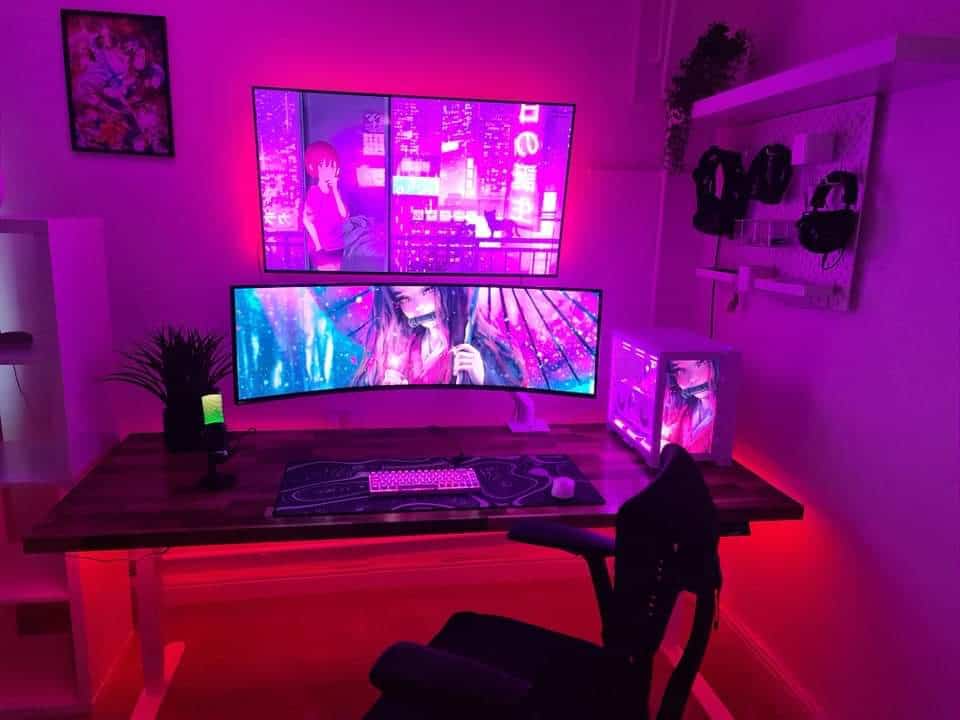
Research indicates that a curved monitor offers 30% more viewing angle than a flat screen.
However, not all gamers agree because curved monitors take up more space, are expensive, and are ill-suited for dual gaming.
Read on to determine whether you can benefit from a curved gaming monitor.
Table of Contents Show
Are Curved Monitors Good for Gaming?
With the rise in modern technology, curved gaming monitors are also making rounds for their unique shape and benefits.
Many scientific studies have proved that curved monitors are better for your eyes as they offer a more comfortable viewing experience and reduce eye fatigue.
We polled some passionate gamers to find out whether or not they prefer curved monitors for gaming. And this is what we found.
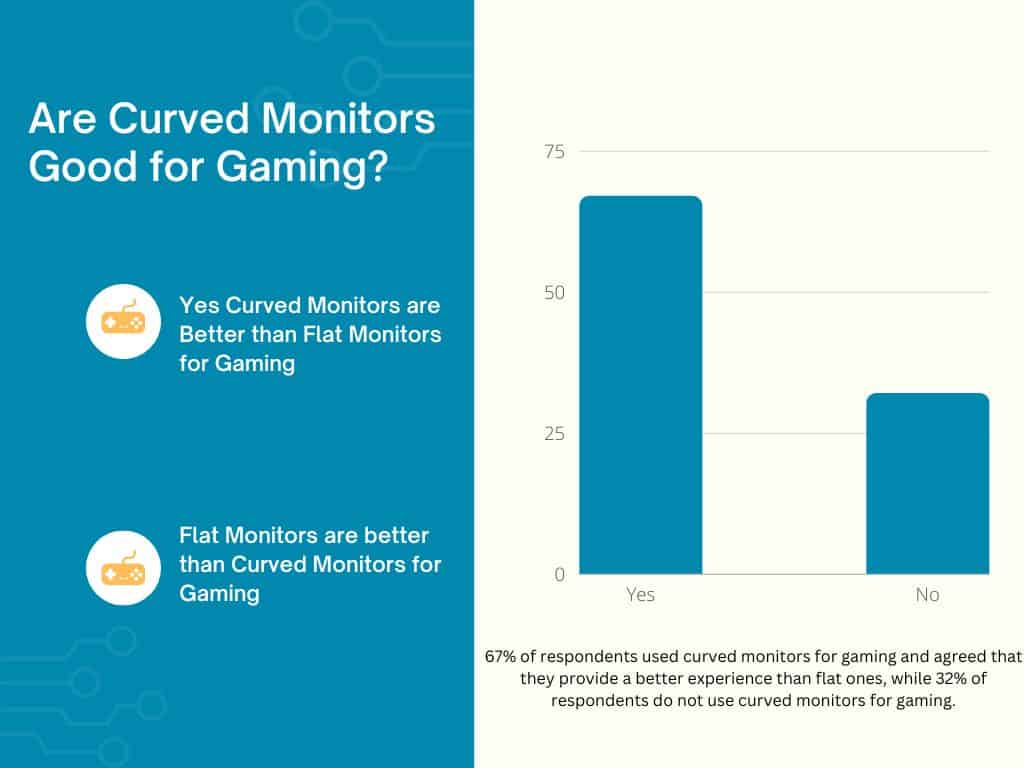
Additionally, many gamers switch to curved monitors for stimulation and shooting games when indulging for significant hours each day.
MSI points out, “Because the screen is curved, the distance between your eyes and the screen remains the same.”
Gamers agree that even a modest-sized curved monitor brings you into action and provides an immersive experience with excellent viewing angles and accuracy.
However, old-school and professional gamers quickly downgrade the benefits of a curved monitor as its many advantages may become a disadvantage in competitions.
For instance, gamers seasoned with flat monitors may find it difficult to switch to curved monitors.
A curved monitor does not fare better than a flat screen in core specs like refresh rate, response time, color depth, and panel technology.
Therefore, the curved monitor has both advantages and disadvantages for gamers!
Pros of Using Curved Monitor for Gaming
Many gamers and experts claim that curved monitor helps elevate the gaming level by reducing eye strain, but there is more to it.
Here are some of the proven advantages of using a curved monitor.
1. Immersive Experience
The perspective of human eyes is not flat but somewhat curved, making it easier to comprehend curved screens.
Our brain arranges objects in space correctly using the three dimensions; length, height, and width.
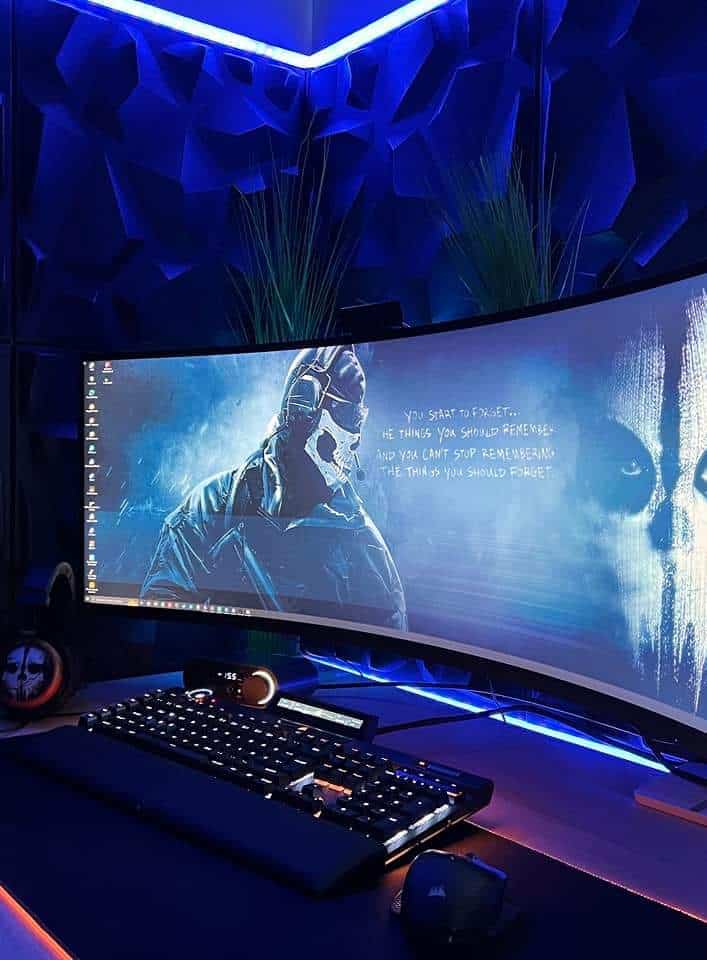
The curved screen uses this technique to create an immersive experience by imitating our eye’s structure.
Therefore, gamers can benefit from better visibility when gaming on a curved monitor as they can perceive each object more clearly.
2. Reduced Reflections
The curved screen has reduced reflections or glare, which is more likely found in the flat screen.
With a better curvature, you can find light reflections from hitting the screen, especially when competitive gaming.
However, keeping the monitor close to the light source will cause reflections. Therefore, it may be wise to turn off the ambient lighting when gaming.
3. Reduced Distortions
The curved monitor utilizes the edges, unlike the flat screen, which helps provides a clear image on all sides.
When seen on a flat screen, the image may become grainy and distorted around the edges.
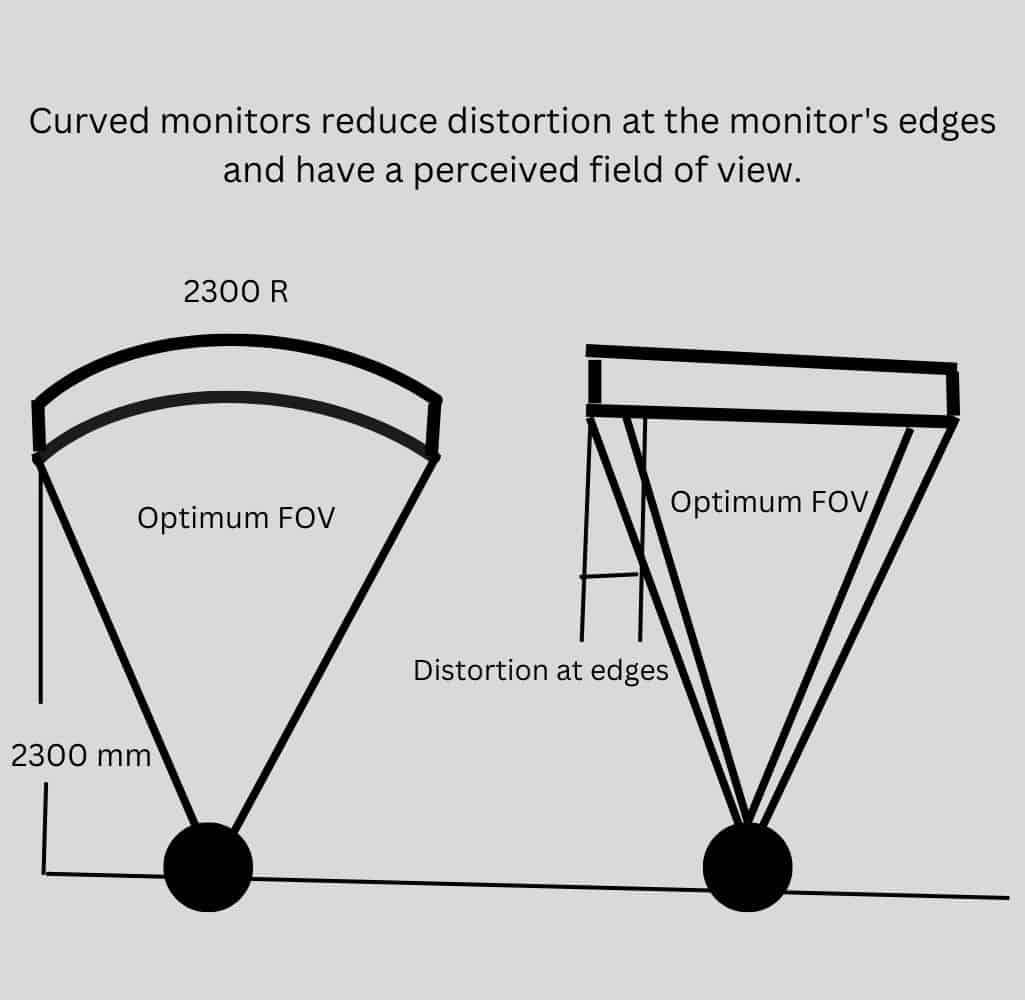
However, the curved shape of the monitor will help reduce the distortion that may appear when seeing the same image on a flat screen.
4. Less Eye Fatigue
You can see the screen for a longer duration with better visibility and less distortion.
Better visibility also means less eye fatigue and head movement, especially during first-person shooting and navigating games.
The curved screen will bring the broader field of view into a single perspective, making it easier to see an image for longer.
Cons of Using a Curved Monitor for Gaming
However, the curved monitor is not free from troubles, as many gamers complain about different gaming issues.
Be prepared to experience some disadvantages when buying a curved gaming monitor.
- Curved monitors are more likely to witness glare than flat screens when placed close to the light source.
- Fixing the curved monitor on the desk will take up more space as it is about 40mm greater than flat screens.
- The curved monitor is a new technology that may encounter problems with refresh rate and response times.
- Sitting too close to the curved monitor means more head and neck movement.
- It offers a limited viewing angle suitable for a single user.
- It is prone to black bars at the sides when watching videos, especially YouTube videos watched on a 16:9 ratio.
- Accessories for the curved monitor are often less varied and are slightly more expensive.
- Ultra-wide curved monitors are expensive and may cost anywhere from 2 to 4 times the price of a standard monitor.
Curved vs. Flat Monitor for Gaming
Along with seeming differences in shape, curved monitors may offer a different experience when it comes to gaming performance.
Here is a table describing some crucial differences between flat and curved monitors for gaming.
| Flat Screen | Curved Screen |
|---|---|
| Flat screen is flatter in shape which portrays an image in a straight line. | Curved screen boasts a curvature design which portrays an image in curved shape. |
| Flat screen is prone to glare in when placed in any position or angle. | Curved screen is prone to glare when placed in a certain angle. |
| The flat screen is flat in shape nonetheless. | The curvature will differ from one brand to another, typically between 1500R to 4000R (Radius). |
| Flat screen is appropriate for all kinds of gaming experience. | Curved screen is more appropriate for FPS and certain type of gaming. |
| Flat screens give the same appearance and feel. | Curved screen is more stylish in appearance. |
| It offers similar refresh rate, response time, and color accuracy across all the devices. | The refresh rate, response time, and color accuracy may be lower. |
How to Choose the Best Curved Monitor for Gaming?
When buying a curved monitor, primarily gaming, you should be wary of some crucial specifications.
1. Optimal Monitor Size
Pro gamers recommend that the screen size or aspect ratio be 16:9 to 21:9 to get the gaming experience.
Choose a more prominent display to get the most out of your curved monitor for maximized efficiency.
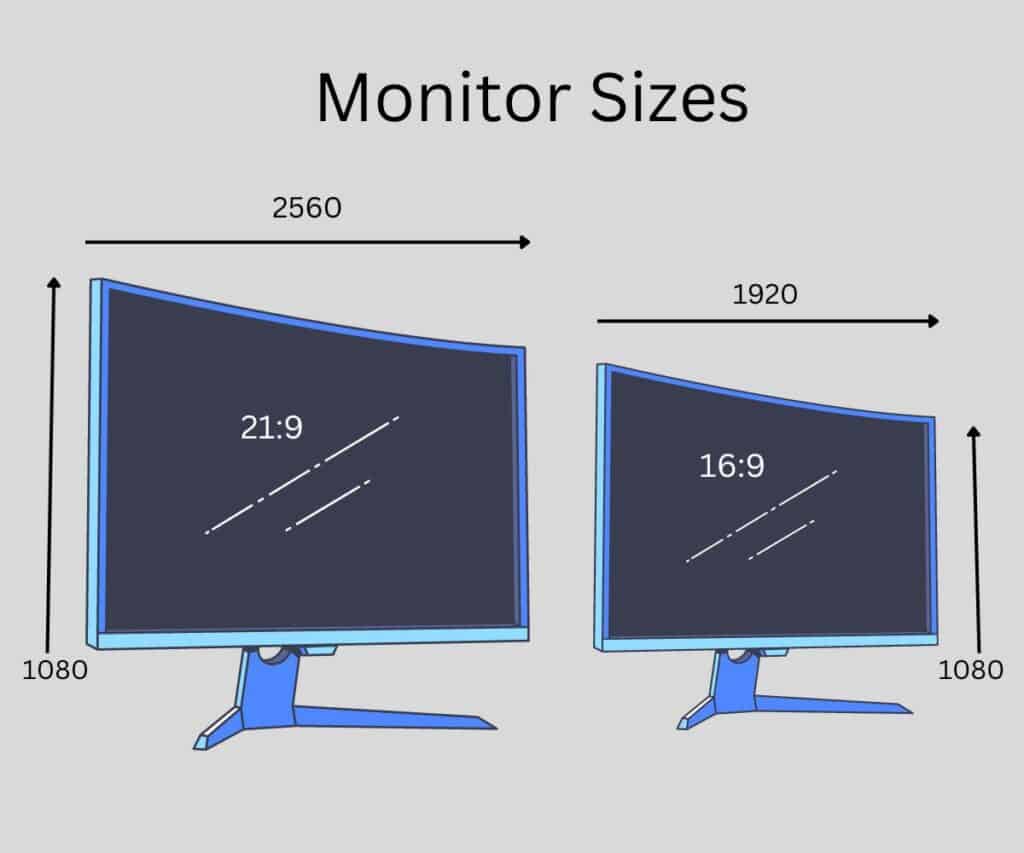
Anything at 27″ or above will suffice because your eye can easily cover the space with an optimal diagonal size of 20-27″.
Be careful of choosing an ultra-wide display such as 32:9 (5120p x 1440p), which is only applicable for selected games.
Read on to learn more about the best monitor size for gaming.
2. Viewing Angle/Curvature
The viewing angle is the most crucial thing for curved monitor gaming.
When choosing a 1800R curved monitor, you should sit straight-on at 1800mm.
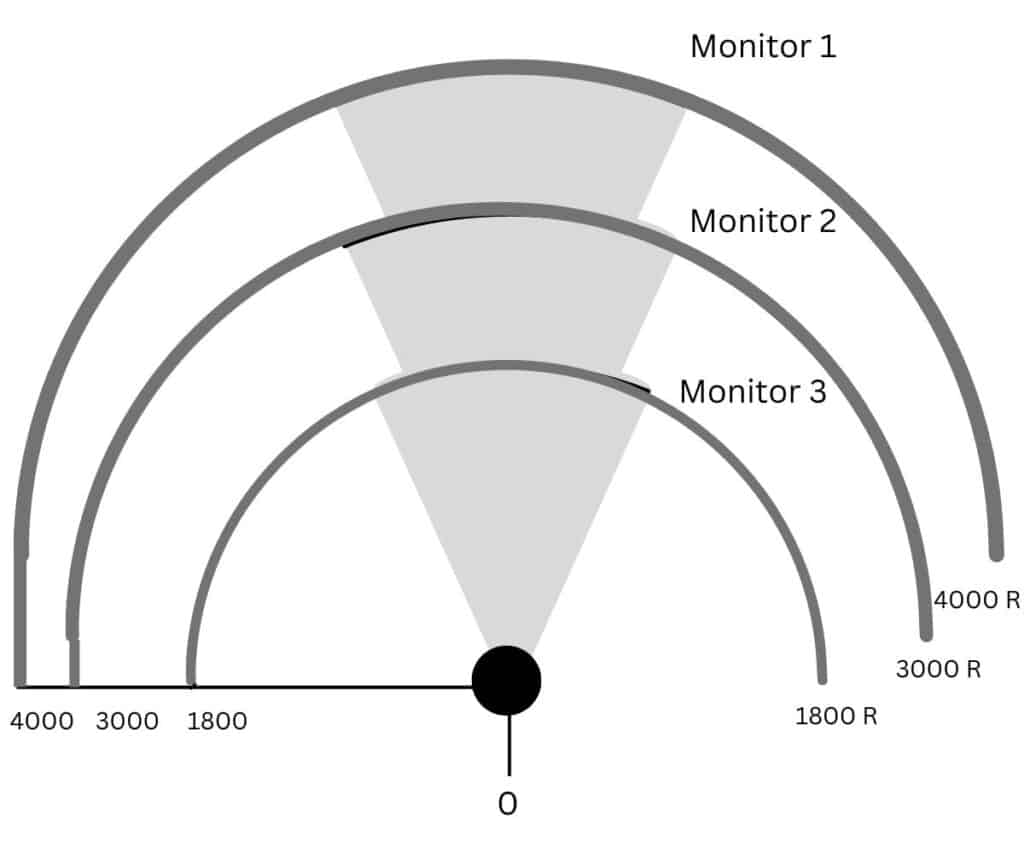
Similarly, a 3000R curved monitor will require sitting straight-on at 3000R. The curved monitor offers better visibility when viewed from a better angle and distance.
The higher the number, the lesser the curve, and the further away the monitor must be from the user to be viewed properly.
3. Resolution
Sharp resolution and color accuracy is the key to the best gaming experience.
Choose curved monitors with at least 1440p resolution to get the best out of gaming.
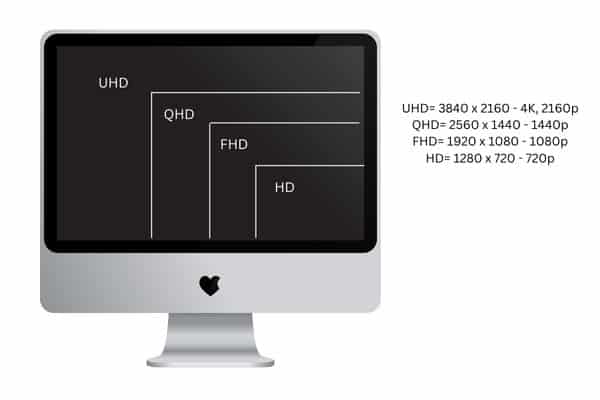
For a more precise and crisper image, choose 4K resolution or 2160p at most, as it offers a better color range, deeper black values, and a crisper image.
Anything more will affect the image’s gaming performance and accurate graphical processing.
4. Refresh Rate
Due to their shape, most curved monitors may fail to provide an optimal response and refresh rate.
Therefore, choosing a monitor with a response time of 2-5 ms would be more suitable.
Similarly, choose a number of frames per second (FPS) at 120-144 Hz.
Note: Ensure your laptop or PC has an optimal graphic processor that would match the curved monitor’s refresh rate.
5. Anti-Tearing Technology
The monitor image is likely to tear when the monitor’s refresh and frame rate vary.
You would usually notice the top and bottom screen frames tear in the middle, usually called image tearing.
Therefore, choose gaming monitors with anti-tearing technology with NVIDIA’s G-Sync and AMD’s FreeSync.
6. Monitor Inputs
Curved monitors are newer additions to the gaming monitor; therefore, they will only take HDMI and DisplayPort inputs.
HDMI 2.0 or 2.1 and DisplayPort 1.4 support a max bandwidth of 18-32.4bps and 4K at 60-120Hz.
Always look for monitors that provide HDMI 2.1 port or DisplayPort 1.4 because older versions may not handle high-resolution displays.
It may come in handy when you connect your monitor to the PC or laptop; otherwise, you may need to get an adapter to connect other inputs to the monitor.
7. High Dynamic Range
Choose curved monitors with HDR technology to get an improved viewing experience.
Higher High Dynamic Range ensures better contrast and vibrant color output.
Get curved monitors with at least 400 cd/m² for optimal viewing, but something in the 600-1,000 cd/m² will be better.
8. Screen Panel Technology
The screen panel technology remains the same for all monitors, but choosing the correct technology is essential for a better gaming experience.
Here are a few examples.
| Screen Panel | Benefits |
|---|---|
| VA Panel | 1. High contrast ratio 2. Better black levels 3. Low backlight bleeding |
| TN Panel | 1. Faster refresh rate 2. Better response time 3. Cheaper than others |
| IPS Panel | 1. Better color constrast 2. Widest color gamut |
| OLED Panel | 1. Better image quality 2. Better contrast 3. Faster refresh rate 4. No backlight bleeding |
Fast-paced gaming, such as FPS, is better played on TN panels, while single-player role-playing games are best played on VA or IPS panels.
Best Curved Monitors For Gaming in 2025
Here are a few curved gaming monitors recommended by pro gamers.
| Best Monitors | Specification | Image |
|---|---|---|
| Sceptre 35-Inch Curved Ultrawide Monitor | The 35" inch curved display with 3440 x 1440 QHD frameless AMD Free sync HDMI Display Port Up to 100Hz. | 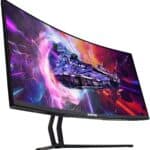 |
| Dell Alienware AW3423DW | 34" display with 3440 x 1440 native resolution and 175 Hz max refresh rate | 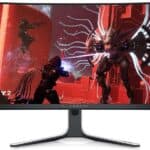 |
| SAMSUNG CJ890 Ultra-wide Monitor | The 49” ultra-wide screen boasts 3840 x 1080 QHD with a 144Hz refresh rate. | 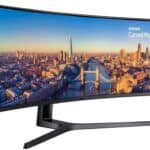 |
| Samsung Odyssey Neo G8 S32BG85 | 32" display with 3840 x 2160 native resolution and 240 Hz max refresh rate | 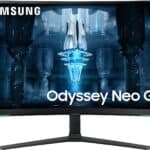 |
| LG 29WN600-W | 21:9 ultra-wide monitor with 2560 x 1080 display and 3-side virtually borderless design |  |
| MSI Optix MAG342CQR | 21:9 ultra-wide monitor offers a 3440 x 1440 display at 144Hz | 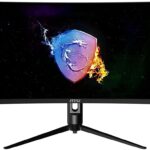 |
| HP OMEN 27" QHD Curved Monitor | 27" display with 2560 x 1440 native resolution and 240 hz max refresh rate | 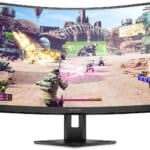 |
Frequently Asked Questions
Why do Most Gamers Prefer VA Panel Curved Monitor?
Curved monitors are great for entertainment, such as gaming, and VA panels are usually preferred because they are easy on the eyes.
A few users may complain about blur regardless of refresh rate, but the VA panel is easy on the eyes, especially for long gaming sessions.
Is Curved Monitor Good for Casual Gaming?
Indeed, curved monitors are great for casual gaming and watching video content.
However, remember that curved monitors are only appropriate for single users. Therefore, using it as an entertainment unit for more than two users may not be reliable.
Is Curved Monitor Good for CSGO?
CSGO or Counter-strike is a popular first-person shooting game optimized for a 16:9 ratio. Therefore, it is best played on monitors with a 16:9 ratio.
A curved monitor with a wider aspect ratio may not be appropriate for CGSO gaming.
Conclusion
Although many gamers opt out of a curved monitor, you should consider trying it out to experience something new.
Curved monitors are an upgrade to a rather dull and limited flat screen. Moreover, it has many in-handy features and benefits, adding to the comfortable gaming experience.
Bookmark this guide to find the list of the best-curved monitors for gaming.
Read more: Is wireless mouse good for gaming?
